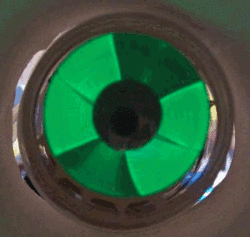- Magic eye tube
-
A magic eye tube gives a visual indication for audio output, radio-frequency signal strength, or other functions. It is also called a cat's eye, or tuning eye tube. These tubes were used by radio receivers from around 1936 onwards, replacing the earlier "Tuneon" neon lamp type tuning indicators, as a tuning aid.
Contents
History
Invented in 1937 by Dr. Allen B. DuMont (who spent most of the 1930s improving the lifetime of cathode ray tubes, and ultimately formed the DuMont Television Network),[1] it is a miniature cathode ray tube, usually with a built-in triode signal amplifier. It usually glows bright green, and the unlit segment on the display narrows as the voltage on a control grid increases. It is used in a circuit that drives the grid with a voltage that changes with signal strength; as the tuning knob is turned, the eye display becomes narrowest when a station is tuned in correctly.
These devices were basically made in two forms – an end-viewed type usually with an octal or side-contact base, and a smaller side-viewed noval B9A based all-glass type. The round cone-shaped fluorescent screen together with the black cap that shielded the red light from the cathode/heater assembly was what prompted the contemporary advertisers to coin the term "Magic Eye", a term still used.
There was a miniature version with wire ends (Mullard DM70/DM71, Mazda 1M1/1M3, GEC/Marconi Y25) intended for battery operation, used in one Ever Ready AM/FM battery receiver with push-pull output, as well as a small number of AM/FM mains receivers, which lit the valve from the 6.3V heater supply via a 220-ohm resistor. One or two small reel-to-reel tape recorders also used the DM70/DM71 to indicate recording level, including a transistorised model with the valve lit from the bias-oscillator voltage.
Use in radios
The purpose of tuning eyes in radio sets is to help tune a station in; the visual aid of the tube makes variations in signal strength more obvious than by ear alone, because the automatic gain control (AGC) action tends to increase the audio volume of a mistuned station, so that the volume varies relatively little as the tuning knob is turned. The tuning eye was driven by the AGC voltage rather than the audio signal.
When, in the early 1950s, FM radio sets were made available on the UK market, many different types of magic eye were made available, with differing displays, but they all worked the same way. Some eyes had a separate small display to light up indicating a stereo signal on FM.
The device consists of a valve with two electrode assemblies, a triode amplifier and a display section consisting of a conical-shaped target anode coated with zinc-silicate or similar. The display section's anode was usually directly connected to the receiver's full HT+ voltage, whilst the triode-anode was (usually internally) connected to a control electrode mounted between cathode and the target-anode, and externally connected to HT+ via a high-value resistor, 1 megohm typically.
When the receiver is switched on but not tuned to a station, the target-anode glows green due to electrons striking it, with the exception of the area by the internal control-electrode. This electrode is typically 150-200V negative with respect to the target-anode, repelling electrons from the target in this region, causing a dark sector to appear on the display.
The control-grid of the triode-amplifier section is connected to a point where a negative control voltage dependent on signal strength is available, e. g. the AGC line in an AM superhet, or the limiter stage or FM detector in an FM receiver (see circuit extract shown). As a station is tuned in the triode-grid becomes more negative with respect to the common cathode.
Other applications
Magic eye tubes were used as the recording level indicator for tape recorders.
A magic eye tube is essentially an inexpensive uncalibrated and not necessarily linear voltage indicator, and can be used wherever an indication of voltage is needed, saving the cost of a more accurate calibrated meter.
The functionality of a magic eye can be achieved with modern semiconductor circuitry and optoelectronic displays. The 100-volt-plus voltages required by magic eyes are not present in modern devices, so the magic eye is now obsolete.
References
- ^ David Weinstein, The Forgotten Network: DuMont and the Birth of American Television. Temple University Press, 2006, p.11
External links
- A more technical description
- Magic eye tubes in action and solid-state magic eye recreation
- Wealth of information on the magic eye
- Precise dB measurements with eye tubes
Categories:- Vacuum tube displays
Wikimedia Foundation. 2010.

